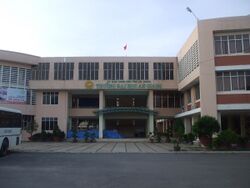An Giang University
Topic: Organization
 From HandWiki - Reading time: 3 min
From HandWiki - Reading time: 3 min
Trường Đại học An Giang, Đại học Quốc gia Thành phố Hồ Chí Minh | |
| Type | Public university |
|---|---|
| Established | 1999 |
Parent institution | Vietnam National University, Ho Chi Minh City |
| Rector | Võ Văn Thắng |
Administrative staff | 815[1] |
| Undergraduates | 10,003[1] |
| Address | 18 Ung Văn Khiêm, phường Đông Xuyên , Long Xuyên , An Giang , Vietnam |
| Campus | Rural 123 acres (0.50 km2)[2] |
| |u}}rs | green, yellow, and white |
| Website | www |
VNU-HCM An Giang University (AGU; Vietnamese: Trường Đại học An Giang, Đại học Quốc gia Thành phố Hồ Chí Minh) is a Vietnamese public university based in the city of Long Xuyen in An Giang Province. With over 10,000 enrolled students annually, it is one of the major educational and research institutions in the Mekong Delta region of Vietnam.[1]
History
In 1975, the school opened as a Teacher Training College. In 1999, it was re-established as the second university in the then-rural Mekong Delta region of Vietnam, with the purpose of serving the provinces of An Giang, Kiên Giang, and Đồng Tháp. Agriculturalist Dr. Võ Tòng Xuân was appointed as its first rector.[3] With the rapid expansion of the school, news spread about the possible sale and privatization of the school, with school leadership denying the information as rumors in 2015.[2] In 2019, the university became officially affiliated as a member of the Vietnam National University, Ho Chi Minh City system.[4][5]
The current rector is Dr. Võ Văn Thắng. AGU has 10,003 students and 815 staff members and lecturers.[1]
Campus
For much of its existence, the university was a single campus near the developing downtown of Long Xuyen. In 2009, the university opened its north campus, which would serve as the school's primary headquarters. Due to its size and central location, the campus sometimes serves as a central meeting ground for the city festivals and expositions.
Academics
AGU has six main schools housing 36 departments and 57 degree programs.[1]
Schools
AGU has six main schools:
- School of Education
- School of Agriculture and Natural Resources
- School of Technology and Environment
- School of Economics and Business Management
- School of Culture and Arts
- School of Philosophy[6]
Institutional Partnerships
An Giang University has a number of partnerships both domestic and international, with universities, non-governmental organizations, and corporations.[7]
Student life
The University has on-campus dormitories. There is an electronic newspaper produced by and for the student body.[8] There multiple student organizations and clubs on-campus.[9]
Notable Alumni and Faculty
- Dr. Võ Tòng Xuân
References
- ↑ 1.0 1.1 1.2 1.3 1.4 "Trường Đại học an Giang chào đón hơn 2.500 tân sinh viên". 2 November 2020. https://dantri.com.vn/giao-duc-huong-nghiep/truong-dai-hoc-an-giang-chao-don-hon-2500-tan-sinh-vien-20201102160039826.htm.
- ↑ 2.0 2.1 "Bán Đại học an Giang chỉ là tin đồn thất thiệt". 25 August 2015. https://nld.com.vn/thoi-su-trong-nuoc/ban-dai-hoc-an-giang-chi-la-tin-don-that-thiet-20150825170051849.htm.
- ↑ "An Giang Universitas - General Information". http://www.agu.edu.vn/en/index.php?mid=2&pg=history.
- ↑ "Đại học An Giang trực thuộc Đại học Quốc gia TP HCM - VnExpress". https://vnexpress.net/dai-hoc-an-giang-truc-thuoc-dai-hoc-quoc-gia-tp-hcm-3967653.html.
- ↑ Trí, Dân (14 August 2019). "Trường Đại học An Giang trở thành trường thành viên của ĐHQG TP. Hồ Chí Minh". https://dantri.com.vn/giao-duc/truong-dai-hoc-an-giang-tro-thanh-truong-thanh-vien-cua-dhqg-tp-ho-chi-minh-20190814203701552.htm. Retrieved 18 July 2023.
- ↑ http://www.agu.edu.vn/?q=en/aguhistory.agu AGU History
- ↑ "Memorandum of Understanding | Drupal". https://www.agu.edu.vn/en/doi-tac-ban-ghi-nho.
- ↑ http://enews.agu.edu.vn/
- ↑ "E-News - SV với Câu lạc bộ". http://enews.agu.edu.vn/index.php?option=com_content&view=category&layout=blog&id=21&Itemid=107.
External links
 |
 KSF
KSF
